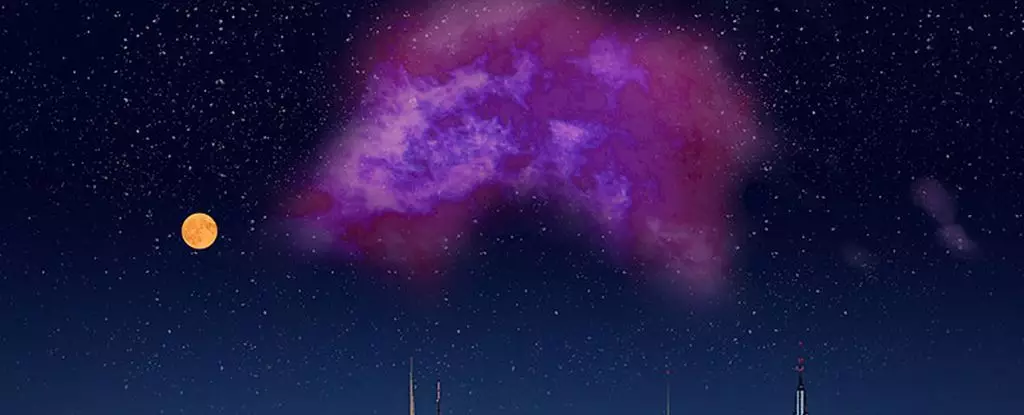In a remarkable leap for astrological science, astronomers have unveiled a breathtaking phenomenon residing just 300 light-years from our Solar System—a colossal cloud of molecular hydrogen named Eos. This discovery marks a transformative moment in our understanding of the cosmos, as it is the first instance where scientists have successfully detected molecular material in the vast expanse of interstellar space. By harnessing the glow emitted from far-ultraviolet light, researchers have illuminated an otherwise obscured aspect of our universe. The fact that scientists are now able to witness something that has eluded detection for eons speaks volumes about human ingenuity and the insatiable quest for knowledge.
The Discovery Process: A Breakthrough in Methodology
What sets this discovery apart is the approach the astrophysicists, led by Blakesley Burkhart from Rutgers University, took to uncover Eos. Traditionally, astronomers have relied on carbon monoxide as a key tracer to study interstellar clouds; however, Eos does not adhere to this model. By instead focusing on the fluorescent emissions of molecular hydrogen exposed to ultraviolet light, Burkhart and her team managed to reveal a hidden landscape teeming with molecular activity. This refreshing methodology not only sheds light on Eos but also presents a promising avenue for future exploration of the invisible correlations that comprise our universe.
The glowing hydrogen molecules that occur when ultraviolet starlight interacts with hydrogen within Eos create a vivid tableau that challenges the notion of interstellar space as a barren expanse. It’s astonishing to realize that although we perceive the night sky as a tapestry filled with stars, an underappreciated richness lurks in the spaces between. Eos, with its crescent shape spanning approximately 80 to 85 light-years, is a prime example of the intricate dance between light and matter that defines our cosmos.
The Cosmic Significance of Eos
The implications of discovering Eos extend far beyond mere academic intrigue. This giant molecular cloud holds about 2,000 solar masses of hydrogen, which is instrumental in star formation. Eos offers a live laboratory for studying how molecular clouds morph into star systems and how galaxies craft their stellar bodies. In essence, it plays a crucial role in our galaxy’s narrative.
Moreover, Eos is in a state of decay, dissipating at a rate of roughly 600 solar masses every million years. While this implies the cloud’s eventual demise—expected to unfold within the next 5.7 million years—such a timeline is relatively fleeting when viewed through the cosmic lens. This transient nature sparks a deeper intrigue regarding the lifecycle and fate of such molecular clouds. Understanding their evolution could unravel the mysteries of galaxy formation and transformation, thereby illuminating the processes that governed our own planet’s birth.
Revolutionizing Our Understanding of the Universe
The discovery of Eos paves the way for an exciting shift in the field of astrophysics. As noted by cosmologist Thavisha Dharmawardena of New York University, this work not only adds to our cosmic understanding but creates a framework for discovering other unseen molecular clouds scattered across the Milky Way and beyond. The potential to unveil what’s in the shadows of our universe could redefine star formation theories and our broader understanding of galactic history.
Through the lens of findings like Eos, we are urged to confront the limitations of our current knowledge and challenge outmoded beliefs about interstellar matter. The notion that interstellar space is largely empty has been cracked open, revealing a tapestry of hidden clouds and material awaiting exploration. The prospect of utilizing far-ultraviolet fluorescence to locate other invisible molecular structures suggests we may stand at the precipice of a new era of astronomical discovery.
A New Dawn for Astronomical Exploration
Looking forward, the implications wrought by the discovery of Eos offer profound possibilities for the future of cosmic research. The realm of invisible cosmic matter is no longer a fringe topic; it has necessitated a re-evaluation of not only how we perceive the universe but also how we explore it. By embracing innovative methodologies—steering away from traditional reliance on carbon monoxide, for instance—scientists are unlocking doors that were once thought sealed.
In dissecting the very fabric of the cosmos, we gain not just facts, but a deeper appreciation of our origins and the forces at play in the universe. Each new discovery of this nature enhances our connection to the intricate dance of creation and destruction that typifies the life cycle of stars and galaxies. As science pushes the boundaries of what we know, we move closer to answering the timeless questions: Where did we come from? How do we fit into the vast cosmos? The unveiling of Eos serves as a reminder that the universe still holds countless truths waiting to be discovered.

